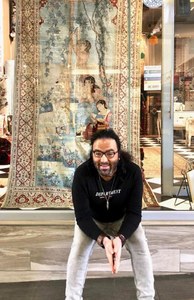The fabrics were all hand painted with brush and pen. They reached their height of popularity specially during the Safavid dynasty.( Esfahan was the capital of the kingdom at the time) To meet the high demand, the Ghalamkar artists began using wooden frames and stamps that were mostly made from old peach trees. This technique drastically expedited the printing process and enabled the artists to create homogeneous patterns. In the past, Ghalamkar fabrics have served multiple purposes.The Safavid Kings, nobles, and the upper class, wore Ghalamkar silk and cotton clothes ornamented with gold and silver. The fabrics were also used to decorate the interior, frequently utilized as curtains, bedspreads, and wall coverings
The exalted art of Ghalamkari is a symbol of longevity, love, and resilience of an ancient tradition that through many peaks and troughs, has been passed to us generation after generation, and heart to heart but It seems that after the pinnacle of popularity, this tradition has entered a stagnant stage and if not for the artists, the legacy may not have survived.
Extract: Farana



